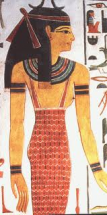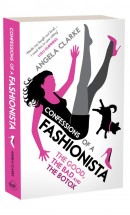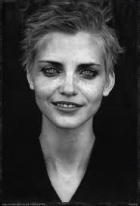Fashion! (Turn To The Left)
I will not lie, I love dressing up.
I love colour and texture; I’m a sucker for embellishment, embroidery and beads. I love over-the-knee boots and necklaces that look like breastplates. In my less confident days I dressed to be ignored (a face-covering fringe as a teenager, dark colours so I could blend in), but I don’t feel like that any more. Dressing up is fun, and (teenage angst aside) we’ve always done it.
But fashion has a shameful, albeit hugely successful, history as a means of limiting women’s physical capabilities, presenting our bodies as things of artifice and display. Put simply: feminism and fashion rarely mix.
In January, Woman’s Hour invited Angela Clarke, author of the memoir Confessions of a Fashionista, to debate this issue with Tanya Sarne, founder of designer label Ghost. (The broadcast is here, if you’d like to listen; the discussion starts just after the 25 minute mark, and I don’t think I’m exaggerating when I tell you Angela kicked ass.) After years working in the fashion industry, she finally left because – among other reasons – it was incompatible with her feminist world-view. I invited her to the blog to talk about what it’s like to be a feminist in fashion, about sidestepping body fascism and rediscovering some joy.
You worked in the fashion industry for years, and then left because you felt you had ‘turned into a gigantic, stuck-up twat.’ A little harsh perhaps, but for people who haven’t read your memoir, can you tell us a bit about what went wrong?
I started to place too great a value on the items I needed to own, wear or be seen with. I believed having a designer handbag made me not only a better person, but also special. When you start rating your handbag above your friends and family it’s time to smack yourself round the face with it. To paraphrase the youth, I was not keeping it real.
The book is a fun, entertaining read – which also chronicles a descent into a particular kind of hell, one where people sniff cake (to avoid the calories), and juniors at Vogue stand clear of passing senior staff, like domestic servants in an Edwardian country house. What was your low point? (And what were the high points?)
Scooping up warm dog poo from the floor of a photographic studio, and being called at 5am from a bored artist were particular low points. I’m still amazed I just got on with both situations, unquestioningly. The high points were all the fun bits; the parties, the clothes, the freebies, and, if I’m honest, the adrenaline hit of successfully producing a huge advertising photoshoot. It’s addictive.
Those of us outside the industry are – of course – on the receiving end of the pressures it applies; we constantly see images of women (and girls) slimmer and more perfect than it is ever possible to be. Size 12 is considered plus-sized, and even on the High Street it’s hard to find well-designed clothes once you’re a size 14 or above. But fashion has never treated women very well; is it worse now than it has been in the past?
I think it’s debatable to say that fashion has never treated women well. There are examples of key fashion figures making positive changes in women’s lives. Coco Chanel was a strong role model to many women, she came from an impoverished background and launched and ran a business at a time when it wasn’t just deemed inappropriate for women to do so, it was virtually unheard of.
Chanel was also instrumental in ridding women of corsetry, and making it socially acceptable for them to cut their hair short and wear trousers. She was reportedly furious when Christian Dior reintroduced corsetry with the New Look in 1947. She said, “I make fashions women can live in, breathe in, feel comfortable in.”
Then there’s Muiccia Prada, one of the most successful designers in the world, she has a PHD in Political Science, was a member of the Communist Party and was an active member of the women’s rights movement in the 1970s. She’s a feminist, and she works in fashion.
But I’m not naive or in denial about the role the fashion industry plays in perpetuating negative body image issues among women. Its a terrible irony that an industry that contributes £21 billion* to our economy, an industry that is predominantly run and staffed by women, and an industry that contains some great examples of influential and powerful women, such as Diane Von Furstenberg and Anna Wintour, is the same industry that is harming so many women.
Fundamentally it comes down to commerce. For as long as fashion is concerned with making money at the expense of everything else, including women’s self worth, it will keep churning out impossible aspirational images. The technical advances in retouch, and its epidemic use, have intensified the problem to catastrophic levels in the last decade. Go back to the 1990s and look at the photographs Peter Lindberg was taking of the 10 most beautiful women in the world then. Yes, these women are extraordinarily stunning, yes they are supermodels, but you can still see dark circles under their eyes, hairs on their lips, veins on their hands and feet. They are slim, but in proportion with their height. They have, with the exception of Kate Moss, boobs and hips. They are women, not girls. They are incredible looking, but they are still human. We need to leave the retouch alone. We need to use women to sell clothes to women. We need to take responsibility for what we’re doing.
What are the positive things happening in fashion for women?
The All Walks campaign celebrates and encourages diversity, including in race, size, age etc. They lobby against the fashion industry’s dependence on unachievable and unhealthy body ideals. They have some big hitters behind them and have had some great successes. It’s exciting to see the industry embrace wider notions of beauty, and produce incredible images outside of what have become the accepted uniform norms. I hope it’s the future.
Given that humans have always wanted to adorn their bodies and given that – quite frankly – it’s fun to dress up, what can women do if they want to have all the fun but none of the self-hatred? Is anyone doing this right?
I recently bought Tavi Gevison’s** Rookie Yearbook One and was delighted to see virtually all the fashion stories are without credits. It doesn’t say where the clothes are from, who they’re designed by, or how much they cost. Here is a magazine edited by a 16-year-old girl, and she has successfully divorced fashion from commerce. It leaves you with the clear message it’s not the brand or value of your clothes that’s important, it’s all the other things that draw you to an item: the colour, the cut, the way it makes you feel, the fun, the creativity. All the good bits.
It reminded me of Bay Garnett’s Cheap Date magazine (1997 – 2005) that used charity shop, second hand or thrift finds for their fashion spreads. It was anti-elitist, anti-advertising, and anti-commerce. One of their coverlines was, ‘Cellulite Problem? Tough Shit!’ It was a great subversive fashion zine, and a fine example of all that’s great about the London fashion scene. It was in the same anarchic spirit that saw us produce Punk, Vivienne Westwood, Katherine Hamnett, Gareth Pugh etc. It isn’t about who or what you’re wearing, but all about how you’re wearing it. Embrace your creativity. Enjoy it.
* The direct value of the UK fashion industry to the UK economy is £21 billion (source: BFC Value of Fashion Report 2010)
** The former teen fashion blogger, who now runs an online magazine, Rookie, written by teen girls, for teen girls.



